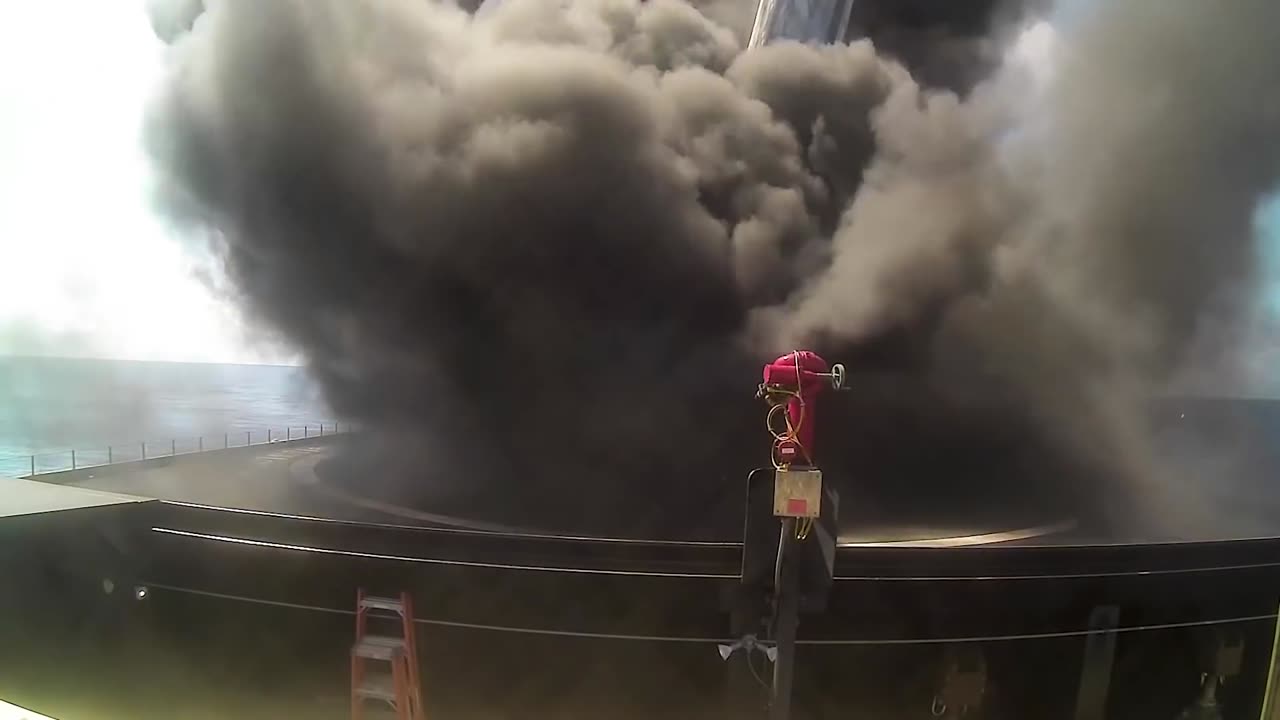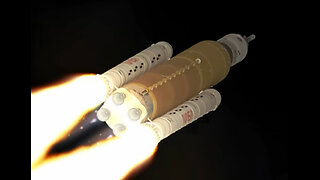Premium Only Content

How Not to Land an Orbital Rocket Booster.
In this video, witness a compilation of SpaceX booster rocket landing attempts that ended in crashes. These failures have paved the way for SpaceX's remarkable successes in rocket recovery and reusability.
SpaceX merch & gift ideas. https://amzn.to/3sCoAOj
Credit: SpaceX
.
.
.
.
.
.
.
.
.
.
.
.
.
.
.
.
rocket crash, rocket crashes, nasa, nasa video,SpaceX, booster rocket, crashes, test failures, rocket landing, space exploration, reusability, rocket recovery, technical challenges, engineering expertise, progress, setbacks, trial and error, advancement, technology, innovation, lessons learned, resilience, determination, successes, failures, near-miss landings, explosions, Mars missions, lunar missions, rocket design, Falcon 9, Falcon Heavy, Starship, rocket prototypes, R&D, payload delivery, space industry, astronauts, launches, re-entry, landing pads, autonomous landing, flight tests, rocket propulsion, navigation systems, aerodynamics, rocket recovery vessels, booster separation, hypersonic speeds, heat shields, safety protocols, orbital mechanics, fuel consumption, parachute deployment, grid fins, landing legs, ocean landings, barge landings, ground infrastructure, flight software, avionics, test range, rocket telemetry, environmental factors, weather conditions, rocket stability, thrust vector control, propellant management, stage separation, failure analysis, flight data analysis, risk mitigation, launch abort systems, rocket manufacturing, Raptor engines, thrust-to-weight ratio, payload fairing, launch trajectory, rocket staging, ground support equipment, mission objectives, rocket engines, thrust control, propulsion system, aerodynamic forces, wind shear, rocket fueling, pre-launch checks, propellant loading, ignition sequence, test stand failures, anomaly investigations, flight termination systems, rocket avionics systems, flight termination systems, rocket recovery operations, propellant tank pressurization, rocket structural integrity, in-flight emergencies, rocket assembly process, ground safety protocols, rocket engine testing, static fire tests, failure analysis reports,
rocket crash, rocket crashes, nasa, nasa video,SpaceX, booster rocket, crashes, test failures, rocket landing, space exploration, reusability, rocket recovery, technical challenges, engineering expertise, progress, setbacks, trial and error, advancement, technology, innovation, lessons learned, resilience, determination, successes, failures, near-miss landings, explosions, Mars missions, lunar missions, rocket design, Falcon 9, Falcon Heavy, Starship, rocket prototypes, R&D, payload delivery, space industry, astronauts, launches, re-entry, landing pads, autonomous landing, flight tests, rocket propulsion, navigation systems, aerodynamics, rocket recovery vessels, booster separation, hypersonic speeds, heat shields, safety protocols, orbital mechanics, fuel consumption, parachute deployment, grid fins, landing legs, ocean landings, barge landings, ground infrastructure, flight software, avionics, test range, rocket telemetry, environmental factors, weather conditions, rocket stability, thrust vector control, propellant management, stage separation, failure analysis, flight data analysis, risk mitigation, launch abort systems, rocket manufacturing, Raptor engines, thrust-to-weight ratio, payload fairing, launch trajectory, rocket staging, ground support equipment, mission objectives, rocket engines, thrust control, propulsion system, aerodynamic forces, wind shear, rocket fueling, pre-launch checks, propellant loading, ignition sequence, test stand failures, anomaly investigations, flight termination systems, rocket avionics systems, flight termination systems, rocket recovery operations, propellant tank pressurization, rocket structural integrity, in-flight emergencies, rocket assembly process, ground safety protocols, rocket engine testing, static fire tests, failure analysis reports, rocket crash, rocket crashes, nasa, nasa video,SpaceX, booster rocket, crashes, test failures, rocket landing, space exploration, reusability, rocket recovery, technical challenges, engineering expertise, progress, setbacks, trial and error, advancement, technology, innovation, lessons learned, resilience, determination, successes, failures, near-miss landings, explosions, Mars missions, lunar missions, rocket design, Falcon 9, Falcon Heavy, Starship, rocket prototypes, R&D, payload delivery, space industry, astronauts, launches, re-entry, landing pads, autonomous landing, flight tests, rocket propulsion, navigation systems, aerodynamics, rocket recovery vessels, booster separation, hypersonic speeds, heat shields, safety protocols, orbital mechanics, fuel consumption, parachute deployment, grid fins, landing legs, ocean landings, barge landings, ground infrastructure, flight software, avionics, test range, rocket telemetry, environmental factors, weather conditions, rocket stability, thrust vector control, propellant management, stage separation, failure analysis, flight data analysis, risk mitigation, launch abort systems, rocket manufacturing, Raptor engines, thrust-to-weight ratio, payload fairing, launch trajectory, rocket staging, ground support equipment, mission objectives, rocket engines, thrust control, propulsion system, aerodynamic forces, wind shear, rocket fueling, pre-launch checks, propellant loading, ignition sequence, test stand failures, anomaly investigations, flight termination systems, rocket avionics systems, flight termination systems, rocket recovery operations, propellant tank pressurization, rocket structural integrity, in-flight emergencies, rocket assembly process, ground safety protocols, rocket engine testing, static fire tests, failure analysis reports,rocket crash, rocket crashes, nasa, nasa video,SpaceX, booster rocket, crashes, test failures, rocket landing, space exploration, reusability, rocket recovery, technical challenges, engineering expertise, progress, setbacks, trial and error, advancement, technology, innovation, lessons learned, resilience, determination, successes, failures, near-miss landings, explosions, Mars missions, lunar missions, rocket design, Falcon 9, Falcon Heavy, Starship, rocket prototypes, R&D, payload delivery, space industry, astronauts, launches, re-entry, landing pads, autonomous landing, flight tests, rocket propulsion, navigation systems, aerodynamics, rocket recovery vessels, booster separation, hypersonic speeds, heat shields, safety protocols, orbital mechanics, fuel consumption, parachute deployment, grid fins, landing legs, ocean landings, barge landings, ground infrastructure, flight software, avionics, test range, rocket telemetry, environmental factors, weather conditions, rocket stability, thrust vector control, propellant management, stage separation, failure analysis, flight data analysis, risk mitigation, launch abort systems, rocket manufacturing, Raptor engines, thrust-to-weight ratio, payload fairing, launch trajectory, rocket staging, ground support equipment, mission objectives, rocket engines, thrust control, propulsion system, aerodynamic forces, wind shear, rocket fueling, pre-launch checks, propellant loading, ignition sequence, test stand failures, anomaly investigations, flight termination systems, rocket avionics systems, flight termination systems, rocket recovery operations, propellant tank pressurization, rocket structural integrity, in-flight emergencies, rocket assembly process, ground safety protocols, rocket engine testing, static fire tests, failure analysis reports,
rocket crash, rocket crashes, nasa, nasa video,SpaceX, booster rocket, crashes, test failures, rocket landing, space exploration, reusability, rocket recovery, technical challenges, engineering expertise, progress, setbacks, trial and error, advancement, technology, innovation, lessons learned, resilience, determination, successes, failures, near-miss landings, explosions, Mars missions, lunar missions, rocket design, Falcon 9, Falcon Heavy, Starship, rocket prototypes, R&D, payload delivery, space industry, astronauts, launches, re-entry, landing pads, autonomous landing, flight tests, rocket propulsion, navigation systems, aerodynamics, rocket recovery vessels, booster separation, hypersonic speeds, heat shields, safety protocols, orbital mechanics, fuel consumption, parachute deployment, grid fins, landing legs, ocean landings, barge landings, ground infrastructure, flight software, avionics, test range, rocket telemetry, environmental factors, weather conditions, rocket stability, thrust vector control, propellant management, stage separation, failure analysis, flight data analysis, risk mitigation, launch abort systems, rocket manufacturing, Raptor engines, thrust-to-weight ratio, payload fairing, launch trajectory, rocket staging, ground support equipment, mission objectives, rocket engines, thrust control, propulsion system, aerodynamic forces, wind shear, rocket fueling, pre-launch checks, propellant loading, ignition sequence, test stand failures, anomaly investigations, flight termination systems, rocket avionics systems, flight termination systems, rocket recovery operations, propellant tank pressurization, rocket structural integrity, in-flight emergencies, rocket assembly process, ground safety protocols, rocket engine testing, static fire tests, failure analysis reports, rocket crash, rocket crashes, nasa, nasa video,SpaceX, booster rocket, crashes, test failures, rocket landing, space exploration, reusability, rocket recovery, technical challenges, engineering expertise, progress, setbacks, trial and error, advancement, technology, innovation, lessons learned, resilience, determination, successes, failures, near-miss landings, explosions, Mars missions, lunar missions, rocket design, Falcon 9, Falcon Heavy, Starship, rocket prototypes, R&D, payload delivery, space industry, astronauts, launches, re-entry, landing pads, autonomous landing, flight tests, rocket propulsion, navigation systems, aerodynamics, rocket recovery vessels, booster separation, hypersonic speeds, heat shields, safety protocols, orbital mechanics, fuel consumption, parachute deployment, grid fins, landing legs, ocean landings, barge landings, ground infrastructure, flight software, avionics, test range, rocket telemetry, environmental factors, weather conditions, rocket stability, thrust vector control, propellant management, stage separation, failure analysis, flight data analysis, risk mitigation, launch abort systems, rocket manufacturing, Raptor engines, thrust-to-weight ratio, payload fairing, launch trajectory, rocket staging, ground support equipment, mission objectives, rocket engines, thrust control, propulsion system, aerodynamic forces, wind shear, rocket fueling, pre-launch checks, propellant loading, ignition sequence, test stand failures, anomaly investigations, flight termination systems, rocket avionics systems, flight termination systems, rocket recovery operations, propellant tank pressurization, rocket structural integrity, in-flight emergencies, rocket assembly process, ground safety protocols, rocket engine testing, static fire tests, failure analysis reports,rocket crash, rocket crashes, nasa, nasa video,SpaceX, booster rocket, crashes, test failures, rocket landing, space exploration, reusability, rocket recovery, technical challenges, engineering expertise, progress, setbacks, trial and error, advancement, technology, innovation, lessons learned, resilience, determination, successes, failures, near-miss landings, explosions, Mars missions, lunar missions, rocket design, Falcon 9, Falcon Heavy, Starship, rocket prototypes, R&D, payload delivery, space industry, astronauts, launches, re-entry, landing pads, autonomous landing, flight tests, rocket propulsion, navigation systems, aerodynamics, rocket recovery vessels, booster separation, hypersonic speeds, heat shields, safety protocols, orbital mechanics, fuel consumption, parachute deployment, grid fins, landing legs, ocean landings, barge landings, ground infrastructure, flight software, avionics, test range, rocket telemetry, environmental factors, weather conditions, rocket stability, thrust vector control, propellant management, stage separation, failure analysis, flight data analysis, risk mitigation, launch abort systems, rocket manufacturing, Raptor engines, thrust-to-weight ratio, payload fairing, launch trajectory, rocket staging, ground support equipment, mission objectives, rocket engines, thrust control, propulsion system, aerodynamic forces, wind shear, rocket fueling, pre-launch checks, propellant loading, ignition sequence, test stand failures, anomaly investigations, flight termination systems, rocket avionics systems, flight termination systems, rocket recovery operations, propellant tank pressurization, rocket structural integrity, in-flight emergencies, rocket assembly process, ground safety protocols, rocket engine testing, static fire tests, failure analysis reports,
rocket crash, rocket crashes, nasa, nasa video,SpaceX, booster rocket, crashes, test failures, rocket landing, space exploration, reusability, rocket recovery, technical challenges, engineering expertise, progress, setbacks, trial and error, advancement, technology, innovation, lessons learned, resilience, determination, successes, failures, near-miss landings, explosions, Mars missions, lunar missions, rocket design, Falcon 9, Falcon Heavy, Starship, rocket prototypes, R&D, payload delivery, space industry, astronauts, launches, re-entry, landing pads, autonomous landing, flight tests, rocket propulsion, navigation systems, aerodynamics, rocket recovery vessels, booster separation, hypersonic speeds, heat shields, safety protocols, orbital mechanics, fuel consumption, parachute deployment, grid fins, landing legs, ocean landings, barge landings, ground infrastructure, flight software, avionics, test range, rocket telemetry, environmental factors, weather conditions, rocket stability, thrust vector control, propellant management, stage separation, failure analysis, flight data analysis, risk mitigation, launch abort systems, rocket manufacturing, Raptor engines, thrust-to-weight ratio, payload fairing, launch trajectory, rocket staging, ground support equipment, mission objectives, rocket engines, thrust control, propulsion system, aerodynamic forces, wind shear, rocket fueling, pre-launch checks, propellant loading, ignition sequence, test stand failures, anomaly investigations, flight termination systems, rocket avionics systems, flight termination systems, rocket recovery operations, propellant tank pressurization, rocket structural integrity, in-flight emergencies, rocket assembly process, ground safety protocols, rocket engine testing, static fire tests, failure analysis reports, rocket crash, rocket crashes, nasa, nasa video,SpaceX, booster rocket, crashes, test failures, rocket landing, space exploration, reusability, rocket recovery, technical challenges, engineering expertise, progress, setbacks, trial and error, advancement, technology, innovation, lessons learned, resilience, determination, successes, failures, near-miss landings, explosions, Mars missions, lunar missions, rocket design, Falcon 9, Falcon Heavy, Starship, rocket prototypes, R&D, payload delivery, space industry, astronauts, launches, re-entry, landing pads, autonomous landing, flight tests, rocket propulsion, navigation systems, aerodynamics, rocket recovery vessels, booster separation, hypersonic speeds, heat shields, safety protocols, orbital mechanics, fuel consumption, parachute deployment, grid fins, landing legs, ocean landings, barge landings, ground infrastructure, flight software, avionics, test range, rocket telemetry, environmental factors, weather conditions, rocket stability, thrust vector control, propellant management, stage separation, failure analysis, flight data analysis, risk mitigation, launch abort systems, rocket manufacturing, Raptor engines, thrust-to-weight ratio, payload fairing, launch trajectory, rocket staging, ground support equipment, mission objectives, rocket engines, thrust control, propulsion system, aerodynamic forces, wind shear, rocket fueling, pre-launch checks, propellant loading, ignition sequence, test stand failures, anomaly investigations, flight termination systems, rocket avionics systems, flight termination systems, rocket recovery operations, propellant tank pressurization, rocket structural integrity, in-flight emergencies, rocket assembly process, ground safety protocols, rocket engine testing, static fire tests, failure analysis reports,rocket crash, rocket crashes, nasa, nasa video,SpaceX, booster rocket, crashes, test failures, rocket landing, space exploration, reusability, rocket recovery, technical challenges, engineering expertise, progress, setbacks, trial and error, advancement, technology, innovation, lessons learned, resilience, determination, successes, failures, near-miss landings, explosions, Mars missions, lunar missions, rocket design, Falcon 9, Falcon Heavy, Starship, rocket prototypes, R&D, payload delivery, space industry, astronauts, launches, re-entry, landing pads, autonomous landing, flight tests, rocket propulsion, navigation systems, aerodynamics, rocket recovery vessels, booster separation, hypersonic speeds, heat shields, safety protocols, orbital mechanics, fuel consumption, parachute deployment, grid fins, landing legs, ocean landings, barge landings, ground infrastructure, flight software, avionics, test range, rocket telemetry, environmental factors, weather conditions, rocket stability, thrust vector control, propellant management, stage separation, failure analysis, flight data analysis, risk mitigation, launch abort systems, rocket manufacturing, Raptor engines, thrust-to-weight ratio, payload fairing, launch trajectory, rocket staging, ground support equipment, mission objectives, rocket engines, thrust control, propulsion system, aerodynamic forces, wind shear, rocket fueling, pre-launch checks, propellant loading, ignition sequence, test stand failures, anomaly investigations, flight termination systems, rocket avionics systems, flight termination systems, rocket recovery operations, propellant tank pressurization, rocket structural integrity, in-flight emergencies, rocket assembly process, ground safety protocols, rocket engine testing, static fire tests, failure analysis reports,
rocket crash, rocket crashes, nasa, nasa video,SpaceX, booster rocket, crashes, test failures, rocket landing, space exploration, reusability, rocket recovery, technical challenges, engineering expertise, progress, setbacks, trial and error, advancement, technology, innovation, lessons learned, resilience, determination, successes, failures, near-miss landings, explosions, Mars missions, lunar missions, rocket design, Falcon 9, Falcon Heavy, Starship, rocket prototypes, R&D, payload delivery, space industry, astronauts, launches, re-entry, landing pads, autonomous landing, flight tests, rocket propulsion, navigation systems, aerodynamics, rocket recovery vessels, booster separation, hypersonic speeds, heat shields, safety protocols, orbital mechanics, fuel consumption, parachute deployment, grid fins, landing legs, ocean landings, barge landings, ground infrastructure, flight software, avionics, test range, rocket telemetry, environmental factors, weather conditions, rocket stability, thrust vector control, propellant management, stage separation, failure analysis, flight data analysis, risk mitigation, launch abort systems, rocket manufacturing, Raptor engines, thrust-to-weight ratio, payload fairing, launch trajectory, rocket staging, ground support equipment, mission objectives, rocket engines, thrust control, propulsion system, aerodynamic forces, wind shear, rocket fueling, pre-launch checks, propellant loading, ignition sequence, test stand failures, anomaly investigations, flight termination systems, rocket avionics systems, flight termination systems, rocket recovery operations, propellant tank pressurization, rocket structural integrity, in-flight emergencies, rocket assembly process, ground safety protocols, rocket engine testing, static fire tests, failure analysis reports, rocket crash, rocket crashes, nasa, nasa video,SpaceX, booster rocket, crashes, test failures, rocket landing, space exploration, reusability, rocket recovery, technical challenges, engineering expertise, progress, setbacks, trial and error, advancement, technology, innovation, lessons learned, resilience, determination, successes, failures, near-miss landings, explosions, Mars missions, lunar missions, rocket design, Falcon 9, Falcon Heavy, Starship, rocket prototypes, R&D, payload delivery, space industry, astronauts, launches, re-entry, landing pads, autonomous landing, flight tests, rocket propulsion, navigation systems, aerodynamics, rocket recovery vessels, booster separation, hypersonic speeds, heat shields, safety protocols, orbital mechanics, fuel consumption, parachute deployment, grid fins, landing legs, ocean landings, barge landings, ground infrastructure, flight software, avionics, test range, rocket telemetry, environmental factors, weather conditions, rocket stability, thrust vector control, propellant management, stage separation, failure analysis, flight data analysis, risk mitigation, launch abort systems, rocket manufacturing, Raptor engines, thrust-to-weight ratio, payload fairing, launch trajectory, rocket staging, ground support equipment, mission objectives, rocket engines, thrust control, propulsion system, aerodynamic forces, wind shear, rocket fueling, pre-launch checks, propellant loading, ignition sequence, test stand failures, anomaly investigations, flight termination systems, rocket avionics systems, flight termination systems, rocket recovery operations, propellant tank pressurization, rocket structural integrity, in-flight emergencies, rocket assembly process, ground safety protocols, rocket engine testing, static fire tests, failure analysis reports,rocket crash, rocket crashes, nasa, nasa video,SpaceX, booster rocket, crashes, test failures, rocket landing, space exploration, reusability, rocket recovery, technical challenges, engineering expertise, progress, setbacks, trial and error, advancement, technology, innovation, lessons learned, resilience, determination, successes, failures, near-miss landings, explosions, Mars missions, lunar missions, rocket design, Falcon 9, Falcon Heavy, Starship, rocket prototypes, R&D, payload delivery, space industry, astronauts, launches, re-entry, landing pads, autonomous landing, flight tests, rocket propulsion, navigation systems, aerodynamics, rocket recovery vessels, booster separation, hypersonic speeds, heat shields, safety protocols, orbital mechanics, fuel consumption, parachute deployment, grid fins, landing legs, ocean landings, barge landings, ground infrastructure, flight software, avionics, test range, rocket telemetry, environmental factors, weather conditions, rocket stability, thrust vector control, propellant management, stage separation, failure analysis, flight data analysis, risk mitigation, launch abort systems, rocket manufacturing, Raptor engines, thrust-to-weight ratio, payload fairing, launch trajectory, rocket staging, ground support equipment, mission objectives, rocket engines, thrust control, propulsion system, aerodynamic forces, wind shear, rocket fueling, pre-launch checks, propellant loading, ignition sequence, test stand failures, anomaly investigations, flight termination systems, rocket avionics systems, flight termination systems, rocket recovery operations, propellant tank pressurization, rocket structural integrity, in-flight emergencies, rocket assembly process, ground safety protocols, rocket engine testing, static fire tests, failure analysis reports,
rocket crash, rocket crashes, nasa, nasa video,SpaceX, booster rocket, crashes, test failures, rocket landing, space exploration, reusability, rocket recovery, technical challenges, engineering expertise, progress, setbacks, trial and error, advancement, technology, innovation, lessons learned, resilience, determination, successes, failures, near-miss landings, explosions, Mars missions, lunar missions, rocket design, Falcon 9, Falcon Heavy, Starship, rocket prototypes, R&D, payload delivery, space industry, astronauts, launches, re-entry, landing pads, autonomous landing, flight tests, rocket propulsion, navigation systems, aerodynamics, rocket recovery vessels, booster separation, hypersonic speeds, heat shields, safety protocols, orbital mechanics, fuel consumption, parachute deployment, grid fins, landing legs, ocean landings, barge landings, ground infrastructure, flight software, avionics, test range, rocket telemetry, environmental factors, weather conditions, rocket stability, thrust vector control, propellant management, stage separation, failure analysis, flight data analysis, risk mitigation, launch abort systems, rocket manufacturing, Raptor engines, thrust-to-weight ratio, payload fairing, launch trajectory, rocket staging, ground support equipment, mission objectives, rocket engines, thrust control, propulsion system, aerodynamic forces, wind shear, rocket fueling, pre-launch checks, propellant loading, ignition sequence, test stand failures, anomaly investigations, flight termination systems, rocket avionics systems, flight termination systems, rocket recovery operations, propellant tank pressurization, rocket structural integrity, in-flight emergencies, rocket assembly process, ground safety protocols, rocket engine testing, static fire tests, failure analysis reports, rocket crash, rocket crashes, nasa, nasa video,SpaceX, booster rocket, crashes, test failures, rocket landing, space exploration, reusability, rocket recovery, technical challenges, engineering expertise, progress, setbacks, trial and error, advancement, technology, innovation, lessons learned, resilience, determination, successes, failures, near-miss landings, explosions, Mars missions, lunar missions, rocket design, Falcon 9, Falcon Heavy, Starship, rocket prototypes, R&D, payload delivery, space industry, astronauts, launches, re-entry, landing pads, autonomous landing, flight tests, rocket propulsion, navigation systems, aerodynamics, rocket recovery vessels, booster separation, hypersonic speeds, heat shields, safety protocols, orbital mechanics, fuel consumption, parachute deployment, grid fins, landing legs, ocean landings, barge landings, ground infrastructure, flight software, avionics, test range, rocket telemetry, environmental factors, weather conditions, rocket stability, thrust vector control, propellant management, stage separation, failure analysis, flight data analysis, risk mitigation, launch abort systems, rocket manufacturing, Raptor engines, thrust-to-weight ratio, payload fairing, launch trajectory, rocket staging, ground support equipment, mission objectives, rocket engines, thrust control, propulsion system, aerodynamic forces, wind shear, rocket fueling, pre-launch checks, propellant loading, ignition sequence, test stand failures, anomaly investigations, flight termination systems, rocket avionics systems, flight termination systems, rocket recovery operations, propellant tank pressurization, rocket structural integrity, in-flight emergencies, rocket assembly process, ground safety protocols, rocket engine testing, static fire tests, failure analysis reports,rocket crash, rocket crashes, nasa, nasa video,SpaceX, booster rocket, crashes, test failures, rocket landing, space exploration, reusability, rocket recovery, technical challenges, engineering expertise, progress, setbacks, trial and error, advancement, technology, innovation, lessons learned, resilience, determination, successes, failures, near-miss landings, explosions, Mars missions, lunar missions, rocket design, Falcon 9, Falcon Heavy, Starship, rocket prototypes, R&D, payload delivery, space industry, astronauts, launches, re-entry, landing pads, autonomous landing, flight tests, rocket propulsion, navigation systems, aerodynamics, rocket recovery vessels, booster separation, hypersonic speeds, heat shields, safety protocols, orbital mechanics, fuel consumption, parachute deployment, grid fins, landing legs, ocean landings, barge landings, ground infrastructure, flight software, avionics, test range, rocket telemetry, environmental factors, weather conditions, rocket stability, thrust vector control, propellant management, stage separation, failure analysis, flight data analysis, risk mitigation, launch abort systems, rocket manufacturing, Raptor engines, thrust-to-weight ratio, payload fairing, launch trajectory, rocket staging, ground support equipment, mission objectives, rocket engines, thrust control, propulsion system, aerodynamic forces, wind shear, rocket fueling, pre-launch checks, propellant loading, ignition sequence, test stand failures, anomaly investigations, flight termination systems, rocket avionics systems, flight termination systems, rocket recovery operations, propellant tank pressurization, rocket structural integrity, in-flight emergencies, rocket assembly process, ground safety protocols, rocket engine testing, static fire tests, failure analysis reports,
rocket crash, rocket crashes, nasa, nasa video,SpaceX, booster rocket, crashes, test failures, rocket landing, space exploration, reusability, rocket recovery, technical challenges, engineering expertise, progress, setbacks, trial and error, advancement, technology, innovation, lessons learned, resilience, determination, successes, failures, near-miss landings, explosions, Mars missions, lunar missions, rocket design, Falcon 9, Falcon Heavy, Starship, rocket prototypes, R&D, payload delivery, space industry, astronauts, launches, re-entry, landing pads, autonomous landing, flight tests, rocket propulsion, navigation systems, aerodynamics, rocket recovery vessels, booster separation, hypersonic speeds, heat shields, safety protocols, orbital mechanics, fuel consumption, parachute deployment, grid fins, landing legs, ocean landings, barge landings, ground infrastructure, flight software, avionics, test range, rocket telemetry, environmental factors, weather conditions, rocket stability, thrust vector control, propellant management, stage separation, failure analysis, flight data analysis, risk mitigation, launch abort systems, rocket manufacturing, Raptor engines, thrust-to-weight ratio, payload fairing, launch trajectory, rocket staging, ground support equipment, mission objectives, rocket engines, thrust control, propulsion system, aerodynamic forces, wind shear, rocket fueling, pre-launch checks, propellant loading, ignition sequence, test stand failures, anomaly investigations, flight termination systems, rocket avionics systems, flight termination systems, rocket recovery operations, propellant tank pressurization, rocket structural integrity, in-flight emergencies, rocket assembly process, ground safety protocols, rocket engine testing, static fire tests, failure analysis reports, rocket crash, rocket crashes, nasa, nasa video,SpaceX, booster rocket, crashes, test failures, rocket landing, space exploration, reusability, rocket recovery, technical challenges, engineering expertise, progress, setbacks, trial and error, advancement, technology, innovation, lessons learned, resilience, determination, successes, failures, near-miss landings, explosions, Mars missions, lunar missions, rocket design, Falcon 9, Falcon Heavy, Starship, rocket prototypes, R&D, payload delivery, space industry, astronauts, launches, re-entry, landing pads, autonomous landing, flight tests, rocket propulsion, navigation systems, aerodynamics, rocket recovery vessels, booster separation, hypersonic speeds, heat shields, safety protocols, orbital mechanics, fuel consumption, parachute deployment, grid fins, landing legs, ocean landings, barge landings, ground infrastructure, flight software, avionics, test range, rocket telemetry, environmental factors, weather conditions, rocket stability, thrust vector control, propellant management, stage separation, failure analysis, flight data analysis, risk mitigation, launch abort systems, rocket manufacturing, Raptor engines, thrust-to-weight ratio, payload fairing, launch trajectory, rocket staging, ground support equipment, mission objectives, rocket engines, thrust control, propulsion system, aerodynamic forces, wind shear, rocket fueling, pre-launch checks, propellant loading, ignition sequence, test stand failures, anomaly investigations, flight termination systems, rocket avionics systems, flight termination systems, rocket recovery operations, propellant tank pressurization, rocket structural integrity, in-flight emergencies, rocket assembly process, ground safety protocols, rocket engine testing, static fire tests, failure analysis reports,rocket crash, rocket crashes, nasa, nasa video,SpaceX, booster rocket, crashes, test failures, rocket landing, space exploration, reusability, rocket recovery, technical challenges, engineering expertise, progress, setbacks, trial and error, advancement, technology, innovation, lessons learned, resilience, determination, successes, failures, near-miss landings, explosions, Mars missions, lunar missions, rocket design, Falcon 9, Falcon Heavy, Starship, rocket prototypes, R&D, payload delivery, space industry, astronauts, launches, re-entry, landing pads, autonomous landing, flight tests, rocket propulsion, navigation systems, aerodynamics, rocket recovery vessels, booster separation, hypersonic speeds, heat shields, safety protocols, orbital mechanics, fuel consumption, parachute deployment, grid fins, landing legs, ocean landings, barge landings, ground infrastructure, flight software, avionics, test range, rocket telemetry, environmental factors, weather conditions, rocket stability, thrust vector control, propellant management, stage separation, failure analysis, flight data analysis, risk mitigation, launch abort systems, rocket manufacturing, Raptor engines, thrust-to-weight ratio, payload fairing, launch trajectory, rocket staging, ground support equipment, mission objectives, rocket engines, thrust control, propulsion system, aerodynamic forces, wind shear, rocket fueling, pre-launch checks, propellant loading, ignition sequence, test stand failures, anomaly investigations, flight termination systems, rocket avionics systems, flight termination systems, rocket recovery operations, propellant tank pressurization, rocket structural integrity, in-flight emergencies, rocket assembly process, ground safety protocols, rocket engine testing, static fire tests, failure analysis reports,
rocket crash, rocket crashes, nasa, nasa video,SpaceX, booster rocket, crashes, test failures, rocket landing, space exploration, reusability, rocket recovery, technical challenges, engineering expertise, progress, setbacks, trial and error, advancement, technology, innovation, lessons learned, resilience, determination, successes, failures, near-miss landings, explosions, Mars missions, lunar missions, rocket design, Falcon 9, Falcon Heavy, Starship, rocket prototypes, R&D, payload delivery, space industry, astronauts, launches, re-entry, landing pads, autonomous landing, flight tests, rocket propulsion, navigation systems, aerodynamics, rocket recovery vessels, booster separation, hypersonic speeds, heat shields, safety protocols, orbital mechanics, fuel consumption, parachute deployment, grid fins, landing legs, ocean landings, barge landings, ground infrastructure, flight software, avionics, test range, rocket telemetry, environmental factors, weather conditions, rocket stability, thrust vector control, propellant management, stage separation, failure analysis, flight data analysis, risk mitigation, launch abort systems, rocket manufacturing, Raptor engines, thrust-to-weight ratio, payload fairing, launch trajectory, rocket staging, ground support equipment, mission objectives, rocket engines, thrust control, propulsion system, aerodynamic forces, wind shear, rocket fueling, pre-launch checks, propellant loading, ignition sequence, test stand failures, anomaly investigations, flight termination systems, rocket avionics systems, flight termination systems, rocket recovery operations, propellant tank pressurization, rocket structural integrity, in-flight emergencies, rocket assembly process, ground safety protocols, rocket engine testing, static fire tests, failure analysis reports, rocket crash, rocket crashes, nasa, nasa video,SpaceX, booster rocket, crashes, test failures, rocket landing, space exploration, reusability, rocket recovery, technical challenges, engineering expertise, progress, setbacks, trial and error, advancement, technology, innovation, lessons learned, resilience, determination, successes, failures, near-miss landings, explosions, Mars missions, lunar missions, rocket design, Falcon 9, Falcon Heavy, Starship, rocket prototypes, R&D, payload delivery, space industry, astronauts, launches, re-entry, landing pads, autonomous landing, flight tests, rocket propulsion, navigation systems, aerodynamics, rocket recovery vessels, booster separation, hypersonic speeds, heat shields, safety protocols, orbital mechanics, fuel consumption, parachute deployment, grid fins, landing legs, ocean landings, barge landings, ground infrastructure, flight software, avionics, test range, rocket telemetry, environmental factors, weather conditions, rocket stability, thrust vector control, propellant management, stage separation, failure analysis, flight data analysis, risk mitigation, launch abort systems, rocket manufacturing, Raptor engines, thrust-to-weight ratio, payload fairing, launch trajectory, rocket staging, ground support equipment, mission objectives, rocket engines, thrust control, propulsion system, aerodynamic forces, wind shear, rocket fueling, pre-launch checks, propellant loading, ignition sequence, test stand failures, anomaly investigations, flight termination systems, rocket avionics systems, flight termination systems, rocket recovery operations, propellant tank pressurization, rocket structural integrity, in-flight emergencies, rocket assembly process, ground safety protocols, rocket engine testing, static fire tests, failure analysis reports,rocket crash, rocket crashes, nasa, nasa video,SpaceX, booster rocket, crashes, test failures, rocket landing, space exploration, reusability, rocket recovery, technical challenges, engineering expertise, progress, setbacks, trial and error, advancement, technology, innovation, lessons learned, resilience, determination, successes, failures, near-miss landings, explosions, Mars missions, lunar missions, rocket design, Falcon 9, Falcon Heavy, Starship, rocket prototypes, R&D, payload delivery, space industry, astronauts, launches, re-entry, landing pads, autonomous landing, flight tests, rocket propulsion, navigation systems, aerodynamics, rocket recovery vessels, booster separation, hypersonic speeds, heat shields, safety protocols, orbital mechanics, fuel consumption, parachute deployment, grid fins, landing legs, ocean landings, barge landings, ground infrastructure, flight software, avionics, test range, rocket telemetry, environmental factors, weather conditions, rocket stability, thrust vector control, propellant management, stage separation, failure analysis, flight data analysis, risk mitigation, launch abort systems, rocket manufacturing, Raptor engines, thrust-to-weight ratio, payload fairing, launch trajectory, rocket staging, ground support equipment, mission objectives, rocket engines, thrust control, propulsion system, aerodynamic forces, wind shear, rocket fueling, pre-launch checks, propellant loading, ignition sequence, test stand failures, anomaly investigations, flight termination systems, rocket avionics systems, flight termination systems, rocket recovery operations, propellant tank pressurization, rocket structural integrity, in-flight emergencies, rocket assembly process, ground safety protocols, rocket engine testing, static fire tests, failure analysis reports,
rocket crash, rocket crashes, nasa, nasa video,SpaceX, booster rocket, crashes, test failures, rocket landing, space exploration, reusability, rocket recovery, technical challenges, engineering expertise, progress, setbacks, trial and error, advancement, technology, innovation, lessons learned, resilience, determination, successes, failures, near-miss landings, explosions, Mars missions, lunar missions, rocket design, Falcon 9, Falcon Heavy, Starship, rocket prototypes, R&D, payload delivery, space industry, astronauts, launches, re-entry, landing pads, autonomous landing, flight tests, rocket propulsion, navigation systems, aerodynamics, rocket recovery vessels, booster separation, hypersonic speeds, heat shields, safety protocols, orbital mechanics, fuel consumption, parachute deployment, grid fins, landing legs, ocean landings, barge landings, ground infrastructure, flight software, avionics, test range, rocket telemetry, environmental factors, weather conditions, rocket stability, thrust vector control, propellant management, stage separation, failure analysis, flight data analysis, risk mitigation, launch abort systems, rocket manufacturing, Raptor engines, thrust-to-weight ratio, payload fairing, launch trajectory, rocket staging, ground support equipment, mission objectives, rocket engines, thrust control, propulsion system, aerodynamic forces, wind shear, rocket fueling, pre-launch checks, propellant loading, ignition sequence, test stand failures, anomaly investigations, flight termination systems, rocket avionics systems, flight termination systems, rocket recovery operations, propellant tank pressurization, rocket structural integrity, in-flight emergencies, rocket assembly process, ground safety protocols, rocket engine testing, static fire tests, failure analysis reports, rocket crash, rocket crashes, nasa, nasa video,SpaceX, booster rocket, crashes, test failures, rocket landing, space exploration, reusability, rocket recovery, technical challenges, engineering expertise, progress, setbacks, trial and error, advancement, technology, innovation, lessons learned, resilience, determination, successes, failures, near-miss landings, explosions, Mars missions, lunar missions, rocket design, Falcon 9, Falcon Heavy, Starship, rocket prototypes, R&D, payload delivery, space industry, astronauts, launches, re-entry, landing pads, autonomous landing, flight tests, rocket propulsion, navigation systems, aerodynamics, rocket recovery vessels, booster separation, hypersonic speeds, heat shields, safety protocols, orbital mechanics, fuel consumption, parachute deployment, grid fins, landing legs, ocean landings, barge landings, ground infrastructure, flight software, avionics, test range, rocket telemetry, environmental factors, weather conditions, rocket stability, thrust vector control, propellant management, stage separation, failure analysis, flight data analysis, risk mitigation, launch abort systems, rocket manufacturing, Raptor engines, thrust-to-weight ratio, payload fairing, launch trajectory, rocket staging, ground support equipment, mission objectives, rocket engines, thrust control, propulsion system, aerodynamic forces, wind shear, rocket fueling, pre-launch checks, propellant loading, ignition sequence, test stand failures, anomaly investigations, flight termination systems, rocket avionics systems, flight termination systems, rocket recovery operations, propellant tank pressurization, rocket structural integrity, in-flight emergencies, rocket assembly process, ground safety protocols, rocket engine testing, static fire tests, failure analysis reports,rocket crash, rocket crashes, nasa, nasa video,SpaceX, booster rocket, crashes, test failures, rocket landing, space exploration, reusability, rocket recovery, technical challenges, engineering expertise, progress, setbacks, trial and error, advancement, technology, innovation, lessons learned, resilience, determination, successes, failures, near-miss landings, explosions, Mars missions, lunar missions, rocket design, Falcon 9, Falcon Heavy, Starship, rocket prototypes, R&D, payload delivery, space industry, astronauts, launches, re-entry, landing pads, autonomous landing, flight tests, rocket propulsion, navigation systems, aerodynamics, rocket recovery vessels, booster separation, hypersonic speeds, heat shields, safety protocols, orbital mechanics, fuel consumption, parachute deployment, grid fins, landing legs, ocean landings, barge landings, ground infrastructure, flight software, avionics, test range, rocket telemetry, environmental factors, weather conditions, rocket stability, thrust vector control, propellant management, stage separation, failure analysis, flight data analysis, risk mitigation, launch abort systems, rocket manufacturing, Raptor engines, thrust-to-weight ratio, payload fairing, launch trajectory, rocket staging, ground support equipment, mission objectives, rocket engines, thrust control, propulsion system, aerodynamic forces, wind shear, rocket fueling, pre-launch checks, propellant loading, ignition sequence, test stand failures, anomaly investigations, flight termination systems, rocket avionics systems, flight termination systems, rocket recovery operations, propellant tank pressurization, rocket structural integrity, in-flight emergencies, rocket assembly process, ground safety protocols, rocket engine testing, static fire tests, failure analysis reports,
rocket crash, rocket crashes, nasa, nasa video,SpaceX, booster rocket, crashes, test failures, rocket landing, space exploration, reusability, rocket recovery, technical challenges, engineering expertise, progress, setbacks, trial and error, advancement, technology, innovation, lessons learned, resilience, determination, successes, failures, near-miss landings, explosions, Mars missions, lunar missions, rocket design, Falcon 9, Falcon Heavy, Starship, rocket prototypes, R&D, payload delivery, space industry, astronauts, launches, re-entry, landing pads, autonomous landing, flight tests, rocket propulsion, navigation systems, aerodynamics, rocket recovery vessels, booster separation, hypersonic speeds, heat shields, safety protocols, orbital mechanics, fuel consumption, parachute deployment, grid fins, landing legs, ocean landings, barge landings, ground infrastructure, flight software, avionics, test range, rocket telemetry, environmental factors, weather conditions, rocket stability, thrust vector control, propellant management, stage separation, failure analysis, flight data analysis, risk mitigation, launch abort systems, rocket manufacturing, Raptor engines, thrust-to-weight ratio, payload fairing, launch trajectory, rocket staging, ground support equipment, mission objectives, rocket engines, thrust control, propulsion system, aerodynamic forces, wind shear, rocket fueling, pre-launch checks, propellant loading, ignition sequence, test stand failures, anomaly investigations, flight termination systems, rocket avionics systems, flight termination systems, rocket recovery operations, propellant tank pressurization, rocket structural integrity, in-flight emergencies, rocket assembly process, ground safety protocols, rocket engine testing, static fire tests, failure analysis reports, rocket crash, rocket crashes, nasa, nasa video,SpaceX, booster rocket, crashes, test failures, rocket landing, space exploration, reusability, rocket recovery, technical challenges, engineering expertise, progress, setbacks, trial and error, advancement, technology, innovation, lessons learned, resilience, determination, successes, failures, near-miss landings, explosions, Mars missions, lunar missions, rocket design, Falcon 9, Falcon Heavy, Starship, rocket prototypes, R&D, payload delivery, space industry, astronauts, launches, re-entry, landing pads, autonomous landing, flight tests, rocket propulsion, navigation systems, aerodynamics, rocket recovery vessels, booster separation, hypersonic speeds, heat shields, safety protocols, orbital mechanics, fuel consumption, parachute deployment, grid fins, landing legs, ocean landings, barge landings, ground infrastructure, flight software, avionics, test range, rocket telemetry, environmental factors, weather conditions, rocket stability, thrust vector control, propellant management, stage separation, failure analysis, flight data analysis, risk mitigation, launch abort systems, rocket manufacturing, Raptor engines, thrust-to-weight ratio, payload fairing, launch trajectory, rocket staging, ground support equipment, mission objectives, rocket engines, thrust control, propulsion system, aerodynamic forces, wind shear, rocket fueling, pre-launch checks, propellant loading, ignition sequence, test stand failures, anomaly investigations, flight termination systems, rocket avionics systems, flight termination systems, rocket recovery operations, propellant tank pressurization, rocket structural integrity, in-flight emergencies, rocket assembly process, ground safety protocols, rocket engine testing, static fire tests, failure analysis reports,rocket crash, rocket crashes, nasa, nasa video,SpaceX, booster rocket, crashes, test failures, rocket landing, space exploration, reusability, rocket recovery, technical challenges, engineering expertise, progress, setbacks, trial and error, advancement, technology, innovation, lessons learned, resilience, determination, successes, failures, near-miss landings, explosions, Mars missions, lunar missions, rocket design, Falcon 9, Falcon Heavy, Starship, rocket prototypes, R&D, payload delivery, space industry, astronauts, launches, re-entry, landing pads, autonomous landing, flight tests, rocket propulsion, navigation systems, aerodynamics, rocket recovery vessels, booster separation, hypersonic speeds, heat shields, safety protocols, orbital mechanics, fuel consumption, parachute deployment, grid fins, landing legs, ocean landings, barge landings, ground infrastructure, flight software, avionics, test range, rocket telemetry, environmental factors, weather conditions, rocket stability, thrust vector control, propellant management, stage separation, failure analysis, flight data analysis, risk mitigation, launch abort systems, rocket manufacturing, Raptor engines, thrust-to-weight ratio, payload fairing, launch trajectory, rocket staging, ground support equipment, mission objectives, rocket engines, thrust control, propulsion system, aerodynamic forces, wind shear, rocket fueling, pre-launch checks, propellant loading, ignition sequence, test stand failures, anomaly investigations, flight termination systems, rocket avionics systems, flight termination systems, rocket recovery operations, propellant tank pressurization, rocket structural integrity, in-flight emergencies, rocket assembly process, ground safety protocols, rocket engine testing, static fire tests, failure analysis reports,
rocket crash, rocket crashes, nasa, nasa video,SpaceX, booster rocket, crashes, test failures, rocket landing, space exploration, reusability, rocket recovery, technical challenges, engineering expertise, progress, setbacks, trial and error, advancement, technology, innovation, lessons learned, resilience, determination, successes, failures, near-miss landings, explosions, Mars missions, lunar missions, rocket design, Falcon 9, Falcon Heavy, Starship, rocket prototypes, R&D, payload delivery, space industry, astronauts, launches, re-entry, landing pads, autonomous landing, flight tests, rocket propulsion, navigation systems, aerodynamics, rocket recovery vessels, booster separation, hypersonic speeds, heat shields, safety protocols, orbital mechanics, fuel consumption, parachute deployment, grid fins, landing legs, ocean landings, barge landings, ground infrastructure, flight software, avionics, test range, rocket telemetry, environmental factors, weather conditions, rocket stability, thrust vector control, propellant management, stage separation, failure analysis, flight data analysis, risk mitigation, launch abort systems, rocket manufacturing, Raptor engines, thrust-to-weight ratio, payload fairing, launch trajectory, rocket staging, ground support equipment, mission objectives, rocket engines, thrust control, propulsion system, aerodynamic forces, wind shear, rocket fueling, pre-launch checks, propellant loading, ignition sequence, test stand failures, anomaly investigations, flight termination systems, rocket avionics systems, flight termination systems, rocket recovery operations, propellant tank pressurization, rocket structural integrity, in-flight emergencies, rocket assembly process, ground safety protocols, rocket engine testing, static fire tests, failure analysis reports, rocket crash, rocket crashes, nasa, nasa video,SpaceX, booster rocket, crashes, test failures, rocket landing, space exploration, reusability, rocket recovery, technical challenges, engineering expertise, progress, setbacks, trial and error, advancement, technology, innovation, lessons learned, resilience, determination, successes, failures, near-miss landings, explosions, Mars missions, lunar missions, rocket design, Falcon 9, Falcon Heavy, Starship, rocket prototypes, R&D, payload delivery, space industry, astronauts, launches, re-entry, landing pads, autonomous landing, flight tests, rocket propulsion, navigation systems, aerodynamics, rocket recovery vessels, booster separation, hypersonic speeds, heat shields, safety protocols, orbital mechanics, fuel consumption, parachute deployment, grid fins, landing legs, ocean landings, barge landings, ground infrastructure, flight software, avionics, test range, rocket telemetry, environmental factors, weather conditions, rocket stability, thrust vector control, propellant management, stage separation, failure analysis, flight data analysis, risk mitigation, launch abort systems, rocket manufacturing, Raptor engines, thrust-to-weight ratio, payload fairing, launch trajectory, rocket staging, ground support equipment, mission objectives, rocket engines, thrust control, propulsion system, aerodynamic forces, wind shear, rocket fueling, pre-launch checks, propellant loading, ignition sequence, test stand failures, anomaly investigations, flight termination systems, rocket avionics systems, flight termination systems, rocket recovery operations, propellant tank pressurization, rocket structural integrity, in-flight emergencies, rocket assembly process, ground safety protocols, rocket engine testing, static fire tests, failure analysis reports,rocket crash, rocket crashes, nasa, nasa video,SpaceX, booster rocket, crashes, test failures, rocket landing, space exploration, reusability, rocket recovery, technical challenges, engineering expertise, progress, setbacks, trial and error, advancement, technology, innovation, lessons learned, resilience, determination, successes, failures, near-miss landings, explosions, Mars missions, lunar missions, rocket design, Falcon 9, Falcon Heavy, Starship, rocket prototypes, R&D, payload delivery, space industry, astronauts, launches, re-entry, landing pads, autonomous landing, flight tests, rocket propulsion, navigation systems, aerodynamics, rocket recovery vessels, booster separation, hypersonic speeds, heat shields, safety protocols, orbital mechanics, fuel consumption, parachute deployment, grid fins, landing legs, ocean landings, barge landings, ground infrastructure, flight software, avionics, test range, rocket telemetry, environmental factors, weather conditions, rocket stability, thrust vector control, propellant management, stage separation, failure analysis, flight data analysis, risk mitigation, launch abort systems, rocket manufacturing, Raptor engines, thrust-to-weight ratio, payload fairing, launch trajectory, rocket staging, ground support equipment, mission objectives, rocket engines, thrust control, propulsion system, aerodynamic forces, wind shear, rocket fueling, pre-launch checks, propellant loading, ignition sequence, test stand failures, anomaly investigations, flight termination systems, rocket avionics systems, flight termination systems, rocket recovery operations, propellant tank pressurization, rocket structural integrity, in-flight emergencies, rocket assembly process, ground safety protocols, rocket engine testing, static fire tests, failure analysis reports,
rocket crash, rocket crashes, nasa, nasa video,SpaceX, booster rocket, crashes, test failures, rocket landing, space exploration, reusability, rocket recovery, technical challenges, engineering expertise, progress, setbacks, trial and error, advancement, technology, innovation, lessons learned, resilience, determination, successes, failures, near-miss landings, explosions, Mars missions, lunar missions, rocket design, Falcon 9, Falcon Heavy, Starship, rocket prototypes, R&D, payload delivery, space industry, astronauts, launches, re-entry, landing pads, autonomous landing, flight tests, rocket propulsion, navigation systems, aerodynamics, rocket recovery vessels, booster separation, hypersonic speeds, heat shields, safety protocols, orbital mechanics, fuel consumption, parachute deployment, grid fins, landing legs, ocean landings, barge landings, ground infrastructure, flight software, avionics, test range, rocket telemetry, environmental factors, weather conditions, rocket stability, thrust vector control, propellant management, stage separation, failure analysis, flight data analysis, risk mitigation, launch abort systems, rocket manufacturing, Raptor engines, thrust-to-weight ratio, payload fairing, launch trajectory, rocket staging, ground support equipment, mission objectives, rocket engines, thrust control, propulsion system, aerodynamic forces, wind shear, rocket fueling, pre-launch checks, propellant loading, ignition sequence, test stand failures, anomaly investigations, flight termination systems, rocket avionics systems, flight termination systems, rocket recovery operations, propellant tank pressurization, rocket structural integrity, in-flight emergencies, rocket assembly process, ground safety protocols, rocket engine testing, static fire tests, failure analysis reports, rocket crash, rocket crashes, nasa, nasa video,SpaceX, booster rocket, crashes, test failures, rocket landing, space exploration, reusability, rocket recovery, technical challenges, engineering expertise, progress, setbacks, trial and error, advancement, technology, innovation, lessons learned, resilience, determination, successes, failures, near-miss landings, explosions, Mars missions, lunar missions, rocket design, Falcon 9, Falcon Heavy, Starship, rocket prototypes, R&D, payload delivery, space industry, astronauts, launches, re-entry, landing pads, autonomous landing, flight tests, rocket propulsion, navigation systems, aerodynamics, rocket recovery vessels, booster separation, hypersonic speeds, heat shields, safety protocols, orbital mechanics, fuel consumption, parachute deployment, grid fins, landing legs, ocean landings, barge landings, ground infrastructure, flight software, avionics, test range, rocket telemetry, environmental factors, weather conditions, rocket stability, thrust vector control, propellant management, stage separation, failure analysis, flight data analysis, risk mitigation, launch abort systems, rocket manufacturing, Raptor engines, thrust-to-weight ratio, payload fairing, launch trajectory, rocket staging, ground support equipment, mission objectives, rocket engines, thrust control, propulsion system, aerodynamic forces, wind shear, rocket fueling, pre-launch checks, propellant loading, ignition sequence, test stand failures, anomaly investigations, flight termination systems, rocket avionics systems, flight termination systems, rocket recovery operations, propellant tank pressurization, rocket structural integrity, in-flight emergencies, rocket assembly process, ground safety protocols, rocket engine testing, static fire tests, failure analysis reports,rocket crash, rocket crashes, nasa, nasa video,SpaceX, booster rocket, crashes, test failures, rocket landing, space exploration, reusability, rocket recovery, technical challenges, engineering expertise, progress, setbacks, trial and error, advancement, technology, innovation, lessons learned, resilience, determination, successes, failures, near-miss landings, explosions, Mars missions, lunar missions, rocket design, Falcon 9, Falcon Heavy, Starship, rocket prototypes, R&D, payload delivery, space industry, astronauts, launches, re-entry, landing pads, autonomous landing, flight tests, rocket propulsion, navigation systems, aerodynamics, rocket recovery vessels, booster separation, hypersonic speeds, heat shields, safety protocols, orbital mechanics, fuel consumption, parachute deployment, grid fins, landing legs, ocean landings, barge landings, ground infrastructure, flight software, avionics, test range, rocket telemetry, environmental factors, weather conditions, rocket stability, thrust vector control, propellant management, stage separation, failure analysis, flight data analysis, risk mitigation, launch abort systems, rocket manufacturing, Raptor engines, thrust-to-weight ratio, payload fairing, launch trajectory, rocket staging, ground support equipment, mission objectives, rocket engines, thrust control, propulsion system, aerodynamic forces, wind shear, rocket fueling, pre-launch checks, propellant loading, ignition sequence, test stand failures, anomaly investigations, flight termination systems, rocket avionics systems, flight termination systems, rocket recovery operations, propellant tank pressurization, rocket structural integrity, in-flight emergencies, rocket assembly process, ground safety protocols, rocket engine testing, static fire tests, failure analysis reports,
rocket crash, rocket crashes, nasa, nasa video,SpaceX, booster rocket, crashes, test failures, rocket landing, space exploration, reusability, rocket recovery, technical challenges, engineering expertise, progress, setbacks, trial and error, advancement, technology, innovation, lessons learned, resilience, determination, successes, failures, near-miss landings, explosions, Mars missions, lunar missions, rocket design, Falcon 9, Falcon Heavy, Starship, rocket prototypes, R&D, payload delivery, space industry, astronauts, launches, re-entry, landing pads, autonomous landing, flight tests, rocket propulsion, navigation systems, aerodynamics, rocket recovery vessels, booster separation, hypersonic speeds, heat shields, safety protocols, orbital mechanics, fuel consumption, parachute deployment, grid fins, landing legs, ocean landings, barge landings, ground infrastructure, flight software, avionics, test range, rocket telemetry, environmental factors, weather conditions, rocket stability, thrust vector control, propellant management, stage separation, failure analysis, flight data analysis, risk mitigation, launch abort systems, rocket manufacturing, Raptor engines, thrust-to-weight ratio, payload fairing, launch trajectory, rocket staging, ground support equipment, mission objectives, rocket engines, thrust control, propulsion system, aerodynamic forces, wind shear, rocket fueling, pre-launch checks, propellant loading, ignition sequence, test stand failures, anomaly investigations, flight termination systems, rocket avionics systems, flight termination systems, rocket recovery operations, propellant tank pressurization, rocket structural integrity, in-flight emergencies, rocket assembly process, ground safety protocols, rocket engine testing, static fire tests, failure analysis reports, rocket crash, rocket crashes, nasa, nasa video,SpaceX, booster rocket, crashes, test failures, rocket landing, space exploration, reusability, rocket recovery, technical challenges, engineering expertise, progress, setbacks, trial and error, advancement, technology, innovation, lessons learned, resilience, determination, successes, failures, near-miss landings, explosions, Mars missions, lunar missions, rocket design, Falcon 9, Falcon Heavy, Starship, rocket prototypes, R&D, payload delivery, space industry, astronauts, launches, re-entry, landing pads, autonomous landing, flight tests, rocket propulsion, navigation systems, aerodynamics, rocket recovery vessels, booster separation, hypersonic speeds, heat shields, safety protocols, orbital mechanics, fuel consumption, parachute deployment, grid fins, landing legs, ocean landings, barge landings, ground infrastructure, flight software, avionics, test range, rocket telemetry, environmental factors, weather conditions, rocket stability, thrust vector control, propellant management, stage separation, failure analysis, flight data analysis, risk mitigation, launch abort systems, rocket manufacturing, Raptor engines, thrust-to-weight ratio, payload fairing, launch trajectory, rocket staging, ground support equipment, mission objectives, rocket engines, thrust control, propulsion system, aerodynamic forces, wind shear, rocket fueling, pre-launch checks, propellant loading, ignition sequence, test stand failures, anomaly investigations, flight ter
-
 7:44
7:44
NASA Videos Plus
11 days agoHumanity Returns to the Moon! 🌕 The Epic Artemis II Launch to Splashdown
39 -
 3:08:37
3:08:37
LumpyPotatoX2
4 hours agoWhere Winds Meet: New Level Cap + Rumble Wallet - #RumbleGaming
26.3K1 -
 LIVE
LIVE
SOLTEKGG
2 hours ago🔴LIVE - Battlefield 6 - Going Pro in RED SEC
355 watching -
 11:37
11:37
tactical_rifleman
2 days agoRare Breed BEATS THE ATF | FRT-15 | Tactical RIfleman
67.5K23 -
 2:51:46
2:51:46
Pepkilla
3 hours agoMore GOLD Camo's PLEASE Grind Call Of Black Ops 7
11K1 -
 1:35:54
1:35:54
LexTronic
2 hours ago $0.46 earnedMetroid Prime Remastered
7.05K -
 12:32
12:32
MetatronGaming
18 hours agoBLIGHT looks AMAZING - Trailer Reaction
28.4K12 -
 LIVE
LIVE
ProRedmanX
2 hours ago $0.63 earnedSunday Morning Coffee & Chaos ☕ | PUBG -> BF6 -> ??? #goonsquad
77 watching -
 5:23
5:23
Memology 101
22 days ago $18.10 earnedReporter HUMILIATES Kamala Harris over "WORLD-CLASS" dodge during interview
28.6K50 -
 LIVE
LIVE
ItsJustChrisTV
2 hours ago $0.62 earnedRescue Rangin'! Lets (try to) Save Some Folks!
65 watching